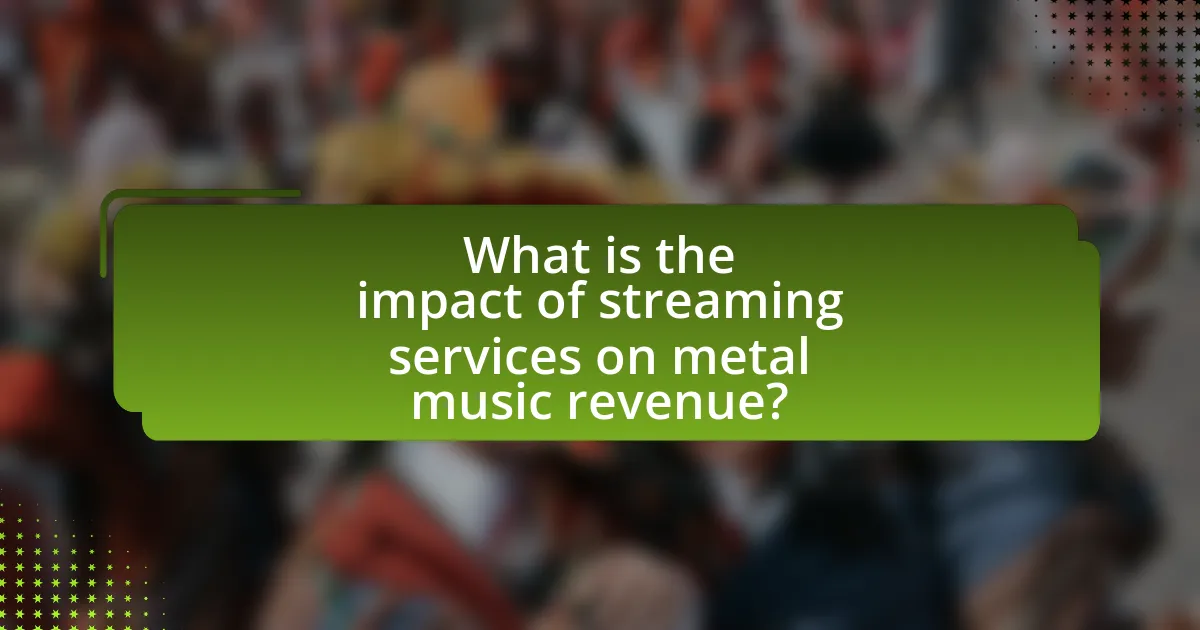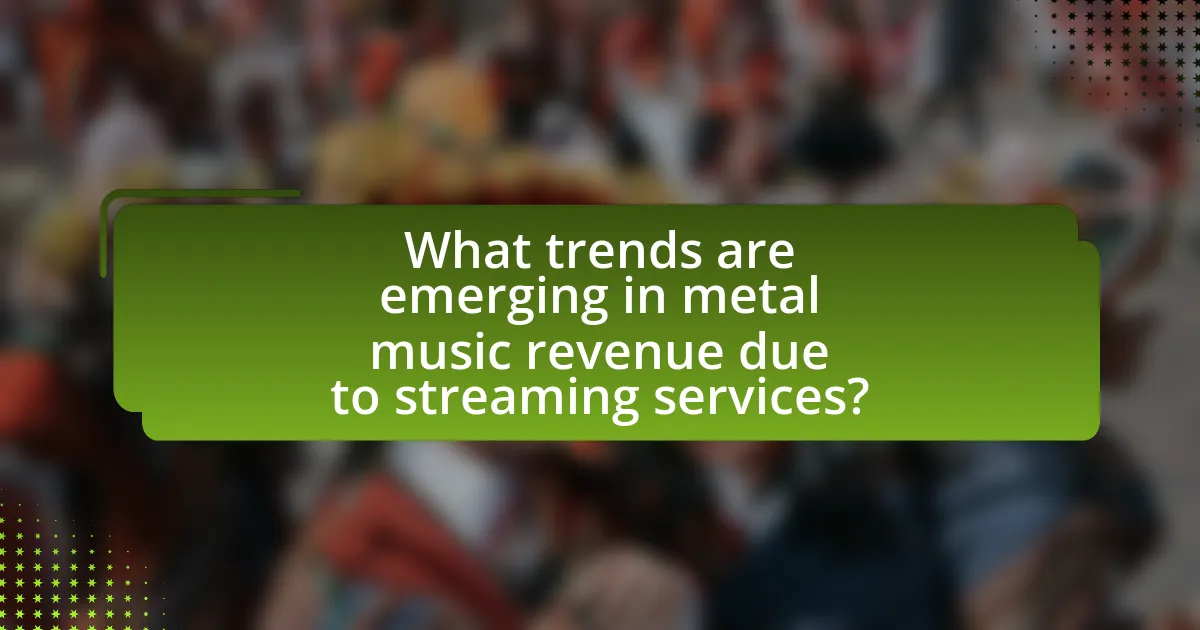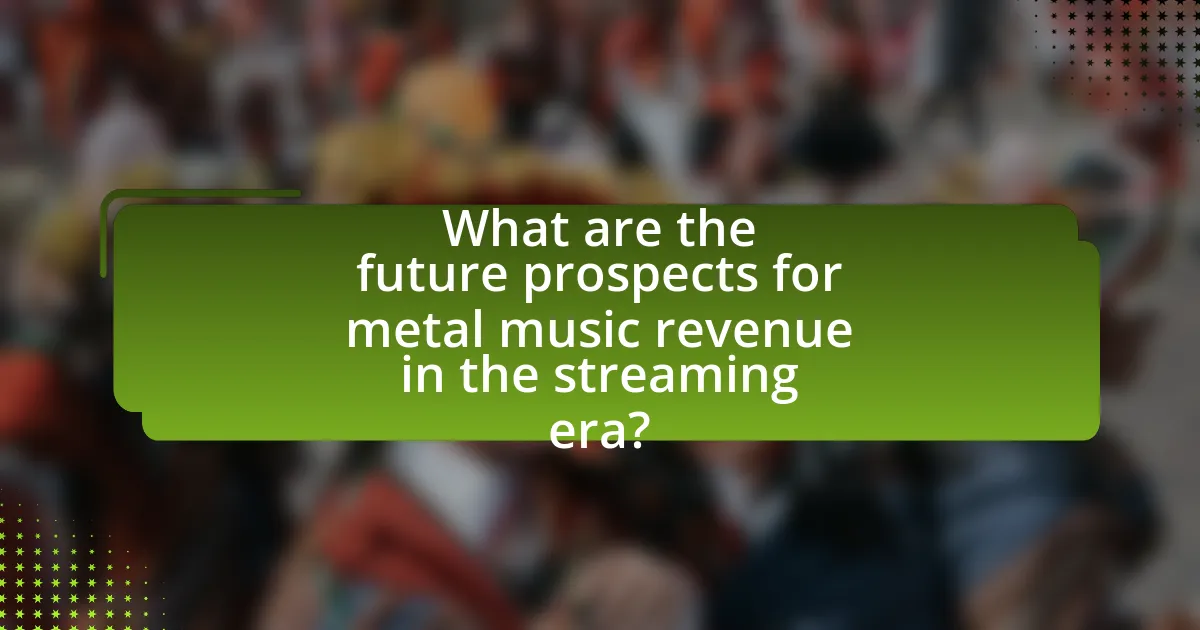The article examines the impact of streaming services on metal music revenue, highlighting the significant reduction in earnings for metal artists due to lower per-stream payouts compared to mainstream genres. It discusses how streaming has transformed music consumption, leading to a decline in physical sales and a reliance on live performances and merchandise for income. Key features of streaming platforms, such as subscription models and playlist placements, are analyzed for their influence on revenue generation. The article also addresses the unique challenges faced by metal artists in the streaming economy, including limited visibility and the need to diversify income streams, while exploring emerging trends and strategies for maximizing revenue in this evolving landscape.

What is the impact of streaming services on metal music revenue?
Streaming services have significantly reduced revenue for metal music artists. According to a 2021 report by the International Federation of the Phonographic Industry (IFPI), streaming accounted for 62% of global recorded music revenue, but metal artists often receive lower per-stream payouts compared to mainstream genres. Additionally, a study by the Music Industry Research Association found that while streaming increases exposure, it does not translate into substantial financial gains for niche genres like metal, leading to a reliance on live performances and merchandise sales for income.
How have streaming services changed the landscape of music consumption?
Streaming services have fundamentally transformed music consumption by providing instant access to vast libraries of music for a subscription fee or free with ads. This shift has led to a decline in physical album sales and digital downloads, with streaming accounting for over 80% of music industry revenue in 2020, according to the Recording Industry Association of America (RIAA). Additionally, streaming platforms have democratized music distribution, allowing independent artists to reach global audiences without traditional gatekeepers, thus reshaping how listeners discover and engage with music.
What are the key features of streaming services that influence revenue?
The key features of streaming services that influence revenue include subscription models, content library size, user interface and experience, and advertising strategies. Subscription models, such as tiered pricing, directly affect revenue by providing users with options that cater to different budgets and preferences, leading to increased user acquisition and retention. A larger content library attracts more subscribers, as diverse offerings enhance user satisfaction and engagement. The user interface and experience play a crucial role in retaining users; a seamless, intuitive design encourages longer listening sessions and reduces churn rates. Finally, effective advertising strategies, including targeted ads and partnerships, can generate additional revenue streams for services that offer free or ad-supported tiers. These features collectively shape the financial success of streaming platforms in the competitive music industry.
How do streaming platforms differ from traditional music sales?
Streaming platforms differ from traditional music sales primarily in their revenue model and accessibility. Streaming services operate on a subscription or ad-supported basis, allowing users to access vast libraries of music for a monthly fee or for free with advertisements, while traditional music sales involve purchasing individual albums or tracks outright. According to the Recording Industry Association of America (RIAA), in 2020, streaming accounted for 83% of the U.S. music industry’s revenue, highlighting a significant shift from physical and digital sales. This model provides artists with ongoing revenue through plays rather than a one-time payment, fundamentally altering how musicians earn income from their work.
What are the financial implications for metal artists using streaming services?
Metal artists face significant financial implications when using streaming services, primarily due to low per-stream payouts. For instance, platforms like Spotify pay artists between $0.003 and $0.005 per stream, which means that a metal artist would need millions of streams to generate substantial income. This model contrasts sharply with traditional album sales, where artists could earn a higher upfront payment per album sold. Additionally, the reliance on streaming can diminish the value of physical merchandise and concert ticket sales, as fans may prioritize streaming over purchasing music directly. Consequently, many metal artists must diversify their revenue streams through merchandise, live performances, and crowdfunding to sustain their careers in the streaming-dominated landscape.
How do streaming royalties compare to physical album sales?
Streaming royalties typically generate significantly lower revenue per unit compared to physical album sales. For instance, artists earn approximately $0.003 to $0.005 per stream on platforms like Spotify, while a physical album sale can yield around $10 to $15 for the artist, depending on the pricing and distribution agreements. This stark difference highlights that an artist would need millions of streams to match the income from just a few thousand album sales, illustrating the financial challenges posed by the shift towards streaming in the music industry.
What percentage of revenue do metal artists typically earn from streaming?
Metal artists typically earn around 10-15% of their total revenue from streaming. This percentage reflects the broader trend in the music industry, where streaming has become a significant source of income, albeit often lower than traditional revenue streams like live performances and merchandise sales. According to a report by the Music Industry Association, streaming accounted for approximately 62% of recorded music revenue in 2020, but individual artist earnings from streaming can vary widely based on factors such as the artist’s popularity and the specific streaming platform’s payout structure.
Why is the metal genre uniquely affected by streaming services?
The metal genre is uniquely affected by streaming services due to its niche audience and the genre’s reliance on live performances for revenue. Unlike mainstream genres, metal often has a smaller but dedicated fanbase that may not generate significant streaming numbers, leading to lower per-stream payouts. According to a 2021 report by the International Federation of the Phonographic Industry, metal music accounts for only 2% of global streaming revenue, highlighting the disparity in financial returns compared to more popular genres. Additionally, many metal bands depend on touring and merchandise sales, which have been disrupted by the rise of streaming, as fans may choose to consume music online rather than attend live shows. This shift impacts the overall revenue model for metal artists, making them more vulnerable to the limitations of streaming platforms.
What challenges do metal artists face in the streaming economy?
Metal artists face significant challenges in the streaming economy, primarily due to low per-stream payouts from platforms. For instance, Spotify pays artists an average of $0.003 to $0.005 per stream, which is insufficient for many metal musicians who rely on volume to generate revenue. Additionally, the genre’s niche audience often results in fewer streams compared to more mainstream genres, further limiting income potential. Furthermore, metal artists frequently struggle with visibility on streaming platforms, as algorithms tend to favor popular music, making it difficult for them to reach new listeners. This combination of low payouts, limited audience reach, and algorithmic bias creates a challenging financial landscape for metal artists in the streaming economy.
How does the fanbase of metal music interact with streaming platforms?
The fanbase of metal music interacts with streaming platforms primarily through active engagement in music discovery, playlist curation, and community building. Metal fans utilize streaming services like Spotify and Apple Music to explore new releases, follow their favorite bands, and create or share playlists that reflect their musical preferences. According to a 2021 report by the International Federation of the Phonographic Industry, streaming accounted for 62% of global recorded music revenue, indicating that metal fans are increasingly relying on these platforms for access to music. Additionally, platforms often feature algorithms that promote metal genres, helping fans discover niche subgenres and emerging artists, which further enhances their interaction with the medium.

What trends are emerging in metal music revenue due to streaming services?
Emerging trends in metal music revenue due to streaming services include increased accessibility and diversification of income streams. Streaming platforms like Spotify and Apple Music have made metal music more accessible to a global audience, leading to a rise in listener engagement and, consequently, revenue. For instance, a report from the International Federation of the Phonographic Industry (IFPI) indicated that streaming accounted for 62% of global recorded music revenue in 2021, with metal genres benefiting from this growth as they attract dedicated fan bases. Additionally, metal artists are increasingly leveraging streaming data to inform touring decisions and merchandise sales, enhancing their overall revenue potential.
How are metal bands adapting their strategies in response to streaming?
Metal bands are adapting their strategies in response to streaming by focusing on direct fan engagement and diversifying revenue streams. Many bands are utilizing platforms like Patreon and Bandcamp to offer exclusive content and merchandise directly to fans, which helps to offset the lower per-stream payouts from services like Spotify. Additionally, bands are increasingly investing in live streaming concerts and virtual events, which gained popularity during the COVID-19 pandemic, allowing them to reach global audiences and generate income despite restrictions on physical performances. This shift is supported by data indicating that live streaming events can attract significant viewership, providing a new revenue source that complements traditional touring and merchandise sales.
What marketing techniques are metal artists using on streaming platforms?
Metal artists are utilizing targeted social media advertising, playlist placements, and direct fan engagement to market their music on streaming platforms. Targeted social media advertising allows artists to reach specific demographics that align with their music style, increasing visibility and engagement. Playlist placements on popular streaming services, such as Spotify and Apple Music, enhance discoverability, as being featured on curated playlists can significantly boost streaming numbers. Additionally, direct fan engagement through live streams, Q&A sessions, and exclusive content fosters a loyal fanbase, encouraging listeners to support the artist’s work. These techniques are supported by data showing that artists who actively engage with their audience and utilize playlists see higher streaming rates and increased revenue from streaming services.
How are live performances being influenced by streaming revenue?
Live performances are increasingly influenced by streaming revenue as artists leverage digital platforms to enhance their visibility and audience engagement. The rise of streaming services has shifted the revenue model for musicians, with many now relying on live shows as a primary source of income, given that streaming payouts are often minimal. For instance, a report from the Recording Industry Association of America (RIAA) indicates that in 2020, live music accounted for 75% of total revenue for many artists, highlighting the importance of performances in a streaming-dominated landscape. Additionally, artists use streaming data to identify fan locations and preferences, allowing them to tailor tours and setlists, ultimately driving ticket sales and enhancing the concert experience.
What role do playlists play in the revenue generation for metal music?
Playlists significantly enhance revenue generation for metal music by increasing exposure and streaming numbers. When metal tracks are featured on popular playlists, they reach a wider audience, leading to higher streaming rates. For instance, a study by the International Federation of the Phonographic Industry (IFPI) indicates that playlists account for over 30% of all music streams, which directly correlates to increased royalties for artists. Additionally, being included in curated playlists can elevate a metal band’s visibility, potentially leading to more merchandise sales and concert ticket purchases, further contributing to overall revenue.
How can metal artists get featured on popular playlists?
Metal artists can get featured on popular playlists by actively promoting their music to playlist curators and utilizing social media platforms to engage with fans and industry professionals. Building relationships with curators through networking, submitting music to playlist submission sites, and leveraging platforms like Spotify for Artists can increase visibility. According to a 2021 report by the International Federation of the Phonographic Industry, playlists are a significant driver of music discovery, with over 60% of listeners using playlists to find new music. This highlights the importance of strategic outreach and engagement for metal artists aiming to secure playlist placements.
What impact do playlists have on listener engagement and sales?
Playlists significantly enhance listener engagement and drive sales in the music industry. By curating songs that align with listener preferences, playlists increase the likelihood of repeated plays and discovery of new tracks, which can lead to higher streaming numbers. For instance, a study by the International Federation of the Phonographic Industry (IFPI) found that tracks featured on popular playlists can experience a 30% increase in streams compared to those not included. This heightened engagement often translates into increased sales, as listeners are more likely to purchase albums or merchandise from artists they discover through playlists.

What are the future prospects for metal music revenue in the streaming era?
The future prospects for metal music revenue in the streaming era appear promising, driven by increasing global streaming subscriptions and the genre’s dedicated fanbase. As of 2023, streaming platforms like Spotify and Apple Music have reported significant growth in user engagement, with Spotify alone boasting over 500 million users, which includes a substantial number of metal music listeners. This trend indicates that metal artists can potentially reach wider audiences and generate revenue through streaming royalties. Additionally, the rise of niche streaming services catering specifically to metal genres, such as Bandcamp and Deezer, further enhances revenue opportunities by allowing artists to connect directly with fans and retain a larger share of earnings.
How might changes in streaming algorithms affect metal music revenue?
Changes in streaming algorithms can significantly impact metal music revenue by altering how often and to whom metal tracks are recommended. For instance, if algorithms prioritize mainstream genres over niche ones like metal, metal artists may receive less exposure, leading to decreased streams and lower revenue. A study by the International Federation of the Phonographic Industry (IFPI) in 2021 indicated that genre-specific playlists drive a substantial portion of streaming revenue; thus, if metal music is deprioritized in these playlists, it could result in a direct decline in earnings for metal musicians. Additionally, changes that favor user-generated content over traditional artist tracks could further marginalize metal music, as it often relies on established artist recognition and dedicated fan bases for revenue generation.
What innovations in streaming technology could benefit metal artists?
Innovations in streaming technology that could benefit metal artists include enhanced audio quality options, interactive live streaming features, and advanced data analytics tools. Enhanced audio quality, such as lossless streaming, allows metal artists to present their music with greater fidelity, appealing to audiophiles and dedicated fans. Interactive live streaming features enable artists to engage with their audience in real-time, fostering a deeper connection and potentially increasing merchandise sales and fan subscriptions. Advanced data analytics tools provide insights into listener demographics and preferences, allowing metal artists to tailor their marketing strategies and optimize their tour locations based on audience data. These innovations collectively enhance the revenue potential for metal artists in the streaming landscape.
How can metal artists leverage data analytics from streaming services?
Metal artists can leverage data analytics from streaming services to gain insights into listener demographics, track performance, and optimize marketing strategies. By analyzing data such as streaming numbers, geographic locations of listeners, and user engagement metrics, artists can identify their most popular songs and target specific audiences more effectively. For instance, Spotify for Artists provides detailed analytics that reveal which tracks are being streamed the most and where the listeners are located, allowing artists to tailor their promotional efforts and tour locations accordingly. This data-driven approach can enhance revenue opportunities by focusing on high-engagement areas and maximizing fan interaction, ultimately leading to increased merchandise sales and concert attendance.
What best practices can metal artists adopt to maximize revenue from streaming?
Metal artists can maximize revenue from streaming by focusing on building a strong online presence, engaging with fans, and leveraging multiple platforms. Establishing a robust social media strategy allows artists to connect directly with their audience, promoting new releases and merchandise effectively. Engaging with fans through live streams, Q&A sessions, and exclusive content fosters loyalty and encourages sharing, which can increase streaming numbers. Additionally, utilizing various streaming platforms, including niche services that cater specifically to metal genres, can enhance visibility and revenue. According to a 2021 report by the International Federation of the Phonographic Industry, artists who actively engage with their fanbase on social media see a 30% increase in streaming activity.
How can artists effectively promote their music on streaming platforms?
Artists can effectively promote their music on streaming platforms by leveraging social media, engaging with fans, and utilizing playlist placements. Social media platforms like Instagram, TikTok, and Twitter allow artists to share snippets of their music, behind-the-scenes content, and personal stories, which can create a deeper connection with their audience. Engaging with fans through live streams, Q&A sessions, and responding to comments fosters loyalty and encourages sharing of the artist’s music. Additionally, securing placements on popular playlists can significantly increase visibility; for instance, Spotify’s editorial playlists can lead to millions of streams, as playlists are a primary way listeners discover new music. According to a 2021 report by the International Federation of the Phonographic Industry, playlists accounted for over 30% of music consumption on streaming platforms, highlighting their importance in promotion.
What strategies can be employed to build a loyal fanbase through streaming?
To build a loyal fanbase through streaming, artists should engage with their audience consistently, offer exclusive content, and utilize social media for direct interaction. Engaging with the audience through regular live streams and Q&A sessions fosters a sense of community, while exclusive content such as behind-the-scenes footage or early access to new music incentivizes fans to remain loyal. Additionally, leveraging social media platforms allows artists to communicate directly with fans, share updates, and create a personal connection, which is crucial for retention. According to a study by Nielsen Music, artists who actively engage with their fans on social media see a 30% increase in fan loyalty, demonstrating the effectiveness of these strategies.



